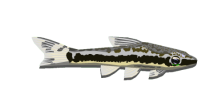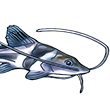Muñoz-Ramírez, CP, E Habit, PJ Unmack, JB Johnson & PF Victoriano, 2016. Low genetic diversity in Diplomystes camposensis, an endemic and endangered catfish from south Chile. Zoological Studies 55:16.
Abstract
Despite the fundamental importance of the family Diplomystidae for understanding catfish evolution, its species are poorly known and most of them endangered. Diplomystes camposensis, restricted to a single river basin in southern Chile, is perhaps the most vulnerable species due to its small geographic range and imminent habitat alterations by dam constructions.Using mitochondrial DNA sequences, we describe the genetic diversity across its entire distribution in the Valdivia basin and test hypotheses related to the impact of glacial cycles on the genetic diversity andstructure. We found that Diplomystes camposensis has low genetic diversity and structure across the entire Valdivia basin along with a pattern of decreasing nucleotide and haplotype diversity from West to East. Demographic analyses showed evidence of population expansion in agreement with the glaciated history of the basin. Analyses of population structure showed no evidence of population subdivision. However, coalescent analyses indicated that very recent subdivision (in the last 50 years) cannot be ruled out. Low genetic diversity and genetic structure across the entire basin suggest that the species might be highly vulnerable to habitat fragmentation. Thus, the imminent construction of hydropower dams represents a serious threat to its conservation. Our results suggest that the low genetic diversity can be the product of the glaciated history of the basin, although the influence of species-specific biological traits may also add to this condition. Despite the overall low genetic diversity, higher diversity was found in the central portion of the basin suggesting high priority of conservation for this area as it might be used as a source population in case translocations are required among potential management plans.
Low genetic diversity in Diplomystes camposensis
- Silurus
- Posts: 12461
- Joined: 31 Dec 2002, 11:35
- I've donated: $12.00!
- My articles: 55
- My images: 896
- My catfish: 1
- My cats species list: 90 (i:1, k:0)
- Spotted: 428
- Location 1: Singapore
- Location 2: Moderator Emeritus
-
Bas Pels
- Posts: 2918
- Joined: 21 Dec 2006, 20:35
- My images: 1
- My cats species list: 28 (i:0, k:0)
- Spotted: 8
- Location 1: the Netherlands
- Location 2: Nijmegen the Netherlands
- Interests: Central American and Uruguayan fishes
Re: Low genetic diversity in Diplomystes camposensis
If I understand it correctly, D campoensis was most likely nearly extinct in a far past, perhaps due to the glacials, and is now repopulating the rest of the river again. The low genetic diversity in the east compared to the west suggests the point of repopulating was in the west, that is, near the ocean.
Being a species with very little diversity, D campoensis is vulnerable for changes a more diverse species could survive. Further, as it only inhabits one river, what happens in this river dictates what happens tgo the species.
Still, I don´t understand why this species is more vulnerable to habitat fragmentation than it would have been in case it had more diversity.
As far as I know, diversity can include genetic defects. A species with a lot of genetic defects will get in danger in case the genetic base gets too small. fragmention will make such a genetic base smaller, but species with litte diversity generally have few, if any, genetic defects. That is, because if they had these defects, the species would have been extinct by now. And having little or no genetic defects, the species is, therefore rather immune to the effects of inbreeding. Or, put differently, it is impossible not to inbred a species with little diversity - all animals are so very related, they could all be siblings. The cheeta is a good example of such a species.
Therefore I wonder what makes this different for D campoensis
Being a species with very little diversity, D campoensis is vulnerable for changes a more diverse species could survive. Further, as it only inhabits one river, what happens in this river dictates what happens tgo the species.
Still, I don´t understand why this species is more vulnerable to habitat fragmentation than it would have been in case it had more diversity.
As far as I know, diversity can include genetic defects. A species with a lot of genetic defects will get in danger in case the genetic base gets too small. fragmention will make such a genetic base smaller, but species with litte diversity generally have few, if any, genetic defects. That is, because if they had these defects, the species would have been extinct by now. And having little or no genetic defects, the species is, therefore rather immune to the effects of inbreeding. Or, put differently, it is impossible not to inbred a species with little diversity - all animals are so very related, they could all be siblings. The cheeta is a good example of such a species.
Therefore I wonder what makes this different for D campoensis
cats have whiskers
-
dw1305
- Posts: 1105
- Joined: 22 Oct 2009, 11:57
- Location 1: Corsham, UK
- Location 2: Bath, UK
- Interests: Natural History, Ecology, Plants, Biotopes, Taxonomy, Nitrification, Cricket & Northern Soul
Re: Low genetic diversity in Diplomystes camposensis
Hi all,
In a genetically diverse population sexual reproduction would produce a range of phenotypes that would then survive and reproduce dependent upon their fitness in the ambient conditions, and natural selection would be more likely to "find" fish that can survive in the altered conditions.
cheers Darrel
I think the answer isn't entirely due to inbreeding (although I think this has depressed fertility in the Cheetah (Acinonyx jubutus)), but more to do with the lack of genetic diversity, meaning that D campoensis doesn't have much raw material for natural selection to work on.Bas Pels wrote:.....Still, I don´t understand why this species is more vulnerable to habitat fragmentation than it would have been in case it had more diversity.
As far as I know, diversity can include genetic defects. A species with a lot of genetic defects will get in danger in case the genetic base gets too small. fragmention will make such a genetic base smaller, but species with litte diversity generally have few, if any, genetic defects. That is, because if they had these defects, the species would have been extinct by now. And having little or no genetic defects, the species is, therefore rather immune to the effects of inbreeding. Or, put differently, it is impossible not to inbred a species with little diversity - all animals are so very related, they could all be siblings. The cheeta is a good example of such a species.
Therefore I wonder what makes this different for D campoensis
The priority for conservation is to maintain the genetic variation that is present. In a fragmented habitat changing conditions may be sub-optimal for the genotype/phenotype present within that fragment, and that population may go extinct.Silurus wrote:Despite the overall low genetic diversity, higher diversity was found in the central portion of the basin suggesting high priority of conservation for this area as it might be used as a source population in case translocations are required among potential management plans.
In a genetically diverse population sexual reproduction would produce a range of phenotypes that would then survive and reproduce dependent upon their fitness in the ambient conditions, and natural selection would be more likely to "find" fish that can survive in the altered conditions.
cheers Darrel
-
radagast1980
- Posts: 1
- Joined: 11 Apr 2016, 04:33
- Location 1: Ann Arbor, Michigan, USA
- Location 2: Chile
Re: Low genetic diversity in Diplomystes camposensis
Hello,
One problem of fragmentation in a species with small distribution range and low genetic diversity is that it will create smaller populations, accentuating all the problems that small populations carry. It will increase the genetic drift on those smaller populations so the remaining genetic diversity will decrease quickly with synergistic problems (extinction vortex). Some processes that benefit from gene flow, such as genetic rescue, will not occur if populations are fragmented. Also, minimum ecological population size will be compromised as the fragmented parts will be smaller that the whole. This will make some populations very prone to demographic stochasticity, risking local extinction. Finally, as Darrel mentioned, low genetic diversity suggest low levels of raw material for adaptive changes to occur. This is especially bad in our rapidly changing world because it precludes species to cope with the changes in the environment.
One problem of fragmentation in a species with small distribution range and low genetic diversity is that it will create smaller populations, accentuating all the problems that small populations carry. It will increase the genetic drift on those smaller populations so the remaining genetic diversity will decrease quickly with synergistic problems (extinction vortex). Some processes that benefit from gene flow, such as genetic rescue, will not occur if populations are fragmented. Also, minimum ecological population size will be compromised as the fragmented parts will be smaller that the whole. This will make some populations very prone to demographic stochasticity, risking local extinction. Finally, as Darrel mentioned, low genetic diversity suggest low levels of raw material for adaptive changes to occur. This is especially bad in our rapidly changing world because it precludes species to cope with the changes in the environment.





